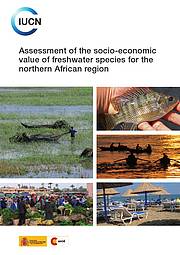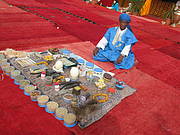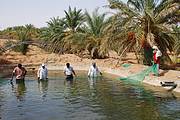Extinction of freshwater species in Northern Africa: a double loss
10 September 2012 | International news release
This is the first time that a study conducted at the species level collates and integrates information on the socio-economic value of freshwater species and the threats to those species in Northern Africa.
Freshwater ecosystems in northern Africa, like others throughout the world, support species that are of direct socio-economic importance to local communities, providing products such as food, construction and craft material, and medicines. However freshwater species in northern Africa also face some of the highest levels of threat in continental Africa, with 28% of all fishes, molluscs, crabs, dragonflies and damselflies, and aquatic plants threatened with extinction.
The findings of this study, coordinated by IUCN Centre for Mediterranean Cooperation (IUCN Med) and conducted by the IUCN Global Species Programme, are most revealing. The high socio-economic value of freshwater species is clearly demonstrated: 46% of fish and 27% of plants utilised in northern Africa provide direct socio-economic benefits. Unfortunately, the freshwater species making up wetland ecosystems are also being rapidly lost through human actions with 25% of the utilised species already at risk of extinction.
In relation to freshwater fishes, at least 378,000 people in Egypt depend directly on activities related to inland fisheries and/or aquaculture, an activity that generated around USD 355.7 million in 2009. In the Maghreb countries, inland fisheries and aquaculture operate at a smaller scale than in Egypt, but still provide an important input to the livelihoods of many thousands of people.
Over a quarter of the freshwater plant species native to northern Africa are used directly by people in the region, and more than 20% of these utilised species are threatened with regional extinction. The Rif mountain range and the Mediterranean coast of Morocco, the area from Kroumiria region in Algeria to the Sejenane region in Tunisia, and the Nile Delta hold large numbers of threatened plants of socio-economic value. Moreover, 66% of the plants included in this study are Crop Wild Relatives (CWR); i.e. wild species with a close genetic similarity to cultivated crops, and as such they are of clear value to people, since they provide the genetic base upon which many commercial crops depend.
The aim of this study is to link IUCN Red List data on the extinction risk for 877 species across northern Africa with information on these freshwater species’ socio-economic value, and to evaluate levels of dependence on wetland services. To do this, 646 species were selected in total, this includes all 128 native fish and 518 native wetland plants, and enables identification of those species that are both threatened and of high socio-economic importance.
“Species identified as both under threat and of high socio-economic value should be prioritised for conservation initiatives aimed at minimising or mitigating impacts on their habitat through integrated management initiatives at catchment and/or sub-catchment level” comments Diego Juffe-Bignoli from the IUCN Global Species Programme’s Freshwater Biodiversity Unit and coordinator of the publication.
“This report clearly demonstrates the strong synergies between targets for the conservation of biodiversity and targets for the protection of sustainable livelihoods based on use of natural resources” comments William Darwall, Manager of IUCN Global Species Programme’s Freshwater Unit.
“Species and ecosystems should not be protected just because they are useful to humans, but because biodiversity sustains all life on earth, including humankind” comments Catherine Numa, from the Species Programme of IUCN Med.
The financial support of the Spanish Agency for International Development Cooperation (AECID) enabled IUCN to carry out this study.
The public presentation of the book is open to the media in the Main Press Conference room on 10 September from 14:30 to 15:00 hrs at the 2012 World Conservation Congress Centre in Jeju, Korea.





